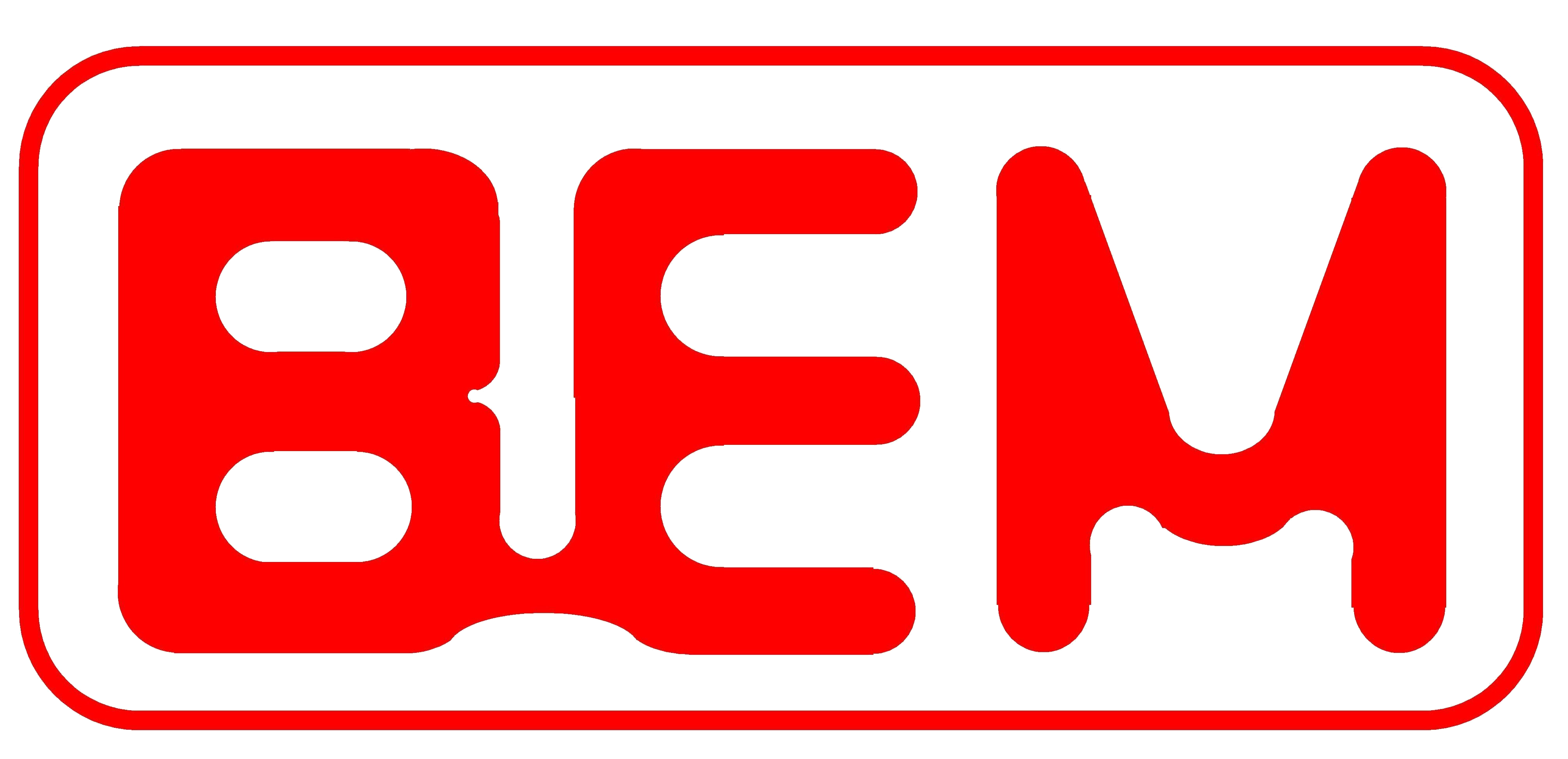Table of culture subject(cell, tissue)
Recommended Configurations of Bioreactors by Target Organisms
Our bioreactors are applicable to all kinds of culture targets from microorganisms to animal cells.We offer bioreactors customized for your targets. Here we introduce some recommended configurations of bioreactors by targets though just an example.
If there is anything we can help you with, please do not hesitate to contact us.
Standard configuration (general microorganisms)
| Benchtop Bioreactors | Pilot/Plant-Scale Bioreactors | |
| Image | 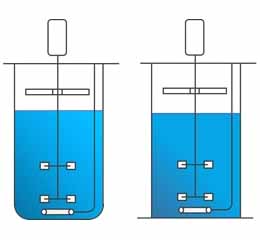 |
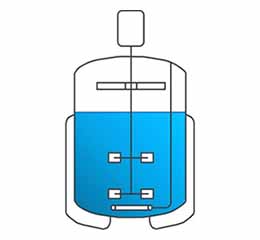 |
| Recommended Configurations (Design) | ||
| Name | MDL series/Bioneer series/Bioneer NEO series | MSJ series/MPF series |
| Total capacity | 0.5L, 1L, 2L, 3L, 5L, 10L | 10L, 20L, 30L, 50L, 70L, 90L(MSJ), 100L, 150L, 200L, 300L ,500L, 700L, 1kL, 1.5kL, 2kL, 3kL, 5kL, and more (MPF) |
| Maximum working volume | 40%~60% of total capacity | 40%~60% of total capacity |
| CIP/SIP | N/A | Applicable |
| Sealing type | Mechanical seal/Magnetic non-seal | Mechanical seal |
| Material | Glass/Stainless | Stainless |
| Recommended Configurations (Design) | ||
| Vessel | Cylindrical vessel (flat-plate bottom/beaker-like) |
Cylindrical vessel (10% Torispherical head) |
| Impeller | Standard Rushton turbine disk | |
| Aeration | Ring sparger | |
| Antifoaming impeller | Recommended | |
| Recommended Configurations (Measuring and Control) | ||
| Temperature | ✔ | |
| Agitating speed | ✔ | |
| DO | ✔(Aerobic culture) | |
| pH | ✔ | |
| Bubble detect | ✔ | |
| Turbidity | ✔ | |
| ORP | ✔(Anaerobic culture) | |
| FEED | ✔ | |
| O2/CO2/N | ― | |
This is a standard configuration of our bioreactor.
You can choose “flat-plate bottom” type or “beaker-like” type benchtop bioreactor. A flat-plate bottom type bioreactor has a temperature control unit at the bottom of it while beaker-like type bioreactor controls its temperature by a silicone rubber band heater. A flat-plate one is safer and a little bit more efficient in heat transfer, but it may cause insufficient flow in a corner when lower agitation speed or high viscosity mixing. We recommend using beaker-like bioreactor in general.
You can also choose a mechanical seal type or a magnetic non-seal type regarding agitation of benchtop bioreactor. It is capable of mixing strongly even in high speed or high viscosity in a mechanical seal type agitation. In a magnetic non-seal type agitation, a tank is perfectly sealed but it is possible that agitation speed falls when in high speed and viscosity because power is magnetically transmitted.
From this standard configuration, we customize them for your situation.
Links
For Fungi/Actinomycetes
| Benchtop Bioreactors | Pilot/Plant-Scale Bioreactors | |
| Image | 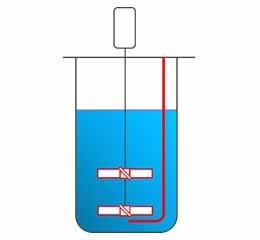 |
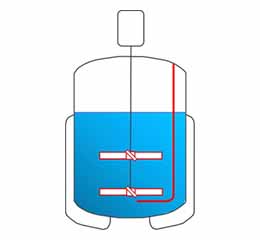 |
| Recommended Configurations (Design) | ||
| Vessel | Cylindrical vessel (beaker-like) |
Cylindrical vessel (10% Torispherical head) |
| Impeller | Pitched paddle type | |
| Impeller | Single hole sparger | |
| Impeller | No need | |
| Recommended Configurations (measuring and control) | ||
| Temperature | ✔ | |
| Agitating speed | ✔ | |
| DO | ✔ | |
| Bubble detect | ✔ | |
| Turbidity | N/A | |
| ORP | ✔(Anaerobic culture) | |
| FEED | ✔ | |
| O2/CO2/N2 | ― | |
A fungus is a kind of microorganisms which consists of filamentous cells called hyphae. An actinomycete is kind of a gram-positive bacteria and has a feature of being long and making mycelium. A fungus is a member of eukaryotes while an actinomycete bacteria. They are phylogenetically different, but morphologically similar and are in treatment in culture.
Fungi and actinomycetes often form pellets in liquid media. They often grow on a tank wall or impeller and that may prevent desirable culture. So you need any kinds of systems which can inhibit cell adhesions or remove adhered cells. That’s why We recommend beaker-like bioreactor, simple-shape impeller and single-hole sparger. These all help preventing cell adhesions.
*There is a wide variety of types in pitched paddle impeller. We select or make an impeller which suits you. If you are interested in, please feel free to contact us.
For Algae
| Benchtop Bioreactors | Pilot/Plant-Scale Bioreactors | |
| Image | 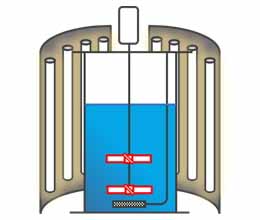 |
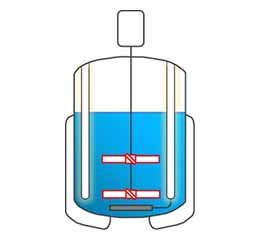 |
| Recommended Configurations (Design) | ||
| Vessel | Cylindrical vessel (Flat-plate bottom) |
Cylindrical vessel (10% Torispherical head) |
| Impeller | Pitched paddle type | |
| Aeration | Sintered sparger | |
| Antifoaming impeller | Recommended | |
| Special | Light irradiation system (only in benchtop and pilot-scale) | |
| Recommended Configurations (measuring and control) | ||
| Temperature | ✔ | |
| Agitating speed | ✔ | |
| DO | ✔(Aerobic culture) | |
| pH | ✔ | |
| Bubble detect | N/A | |
| Turbidity | N/A | |
| ORP | ✔(Anaerobic culture) | |
| FEED | ✔ | |
| O2/CO2/N2 | O2/CO2 | |
The term “algae” refers to microorganisms which photosynthesize. It includes a wide variety of species: From bacteria such as cyanobacteria to eukaryotes such as Euglena.
Among these group of algae, Euglena and Haematococcus, which are well-studied for use in bioindustry, are known that they are sensitive to shear force. So we recommend using pitched-paddle type or helical ribbon impeller, which can stir gently.
O2 and CO2 concentration is an important factor for the culture of algae. Adding O2 and CO2 gases is recommended. Light condition is also important for algae. We offer closed photobioreactor system and it will help your research, development and manufacturing using algae. *There is a wide variety of types in pitched paddle impeller. We select or make an impeller which suits you. If you are interested in, please feel free to contact us.
For Animal cells (insect/mammal) suspension and adherent culture
| Benchtop Bioreactors | Pilot/Plant-Scale Bioreactors | |
| Image | 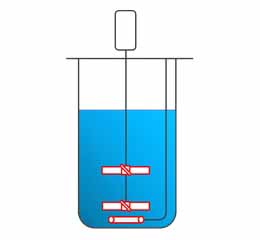 |
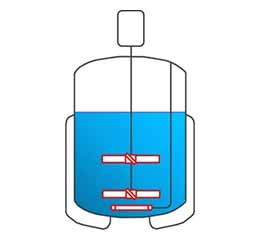 |
| Recommended Configurations (Design) | ||
| Vessel | Cylindrical vessel (beaker-like) |
Cylindrical vessel (10% Torispherical head) |
| Impeller | Pitched paddle type | |
| Aeration | Microbubble sparger | |
| Antifoaming impeller | No need | |
| Recommended Configurations (measuring and control) | ||
| Temperature | ✔ | |
| Agitating speed | ✔ | |
| DO | ✔(Aerobic culture) | |
| pH | ✔ | |
| Bubble detect | No need | |
| Turbidity | ✔ | |
| ORP | ― | |
| FEED | ✔ | |
| O2/CO2/N2 | O2/CO2 | |
Insect cells
Since insect cells are eukaryotic cells, they can produce correctly folded proteins which are derived from eukaryotes such as a human. They are easier to handle than mammalian cells and there are established ways to express recombinant proteins, such as a baculovirus expression system. They are suitable for the large production of recombinant proteins.
It is known that insect cells in culture need a large amount of O2, especially when infected with baculovirus. We recommend using microbubble sparger and add O2 gas.
Mammalian cells
Mammalian cells can not only fold proteins derived from eukaryotes including human correctly but also carry out post-translational modifications such as glycosylation same as humans. mammalian cells are used in biopharmaceutical manufacturing including antibody drugs production, where glycosylation is critical for activity of these drugs.
Culture conditions of mammalian cells are more strict than any other cell strains. Especially, control of pH and DO is thought to be essential to high-density culture and the yield of uniform and high-quality products. Mammalian cells are sensitive to shear force so that agitation speed must be slow and therefore DO tend to low. For that, Adding O2 and CO2 gases, using microbubble sparger and applying a pitched puddle type impeller which realizes a low shear stress and a high KLa agitation are recommended.
*There is a wide variety of types in pitched paddle impeller. We select or make an impeller which suits you. If you are interested in, please feel free to contact us.
For Plant cells(callus)
| Benchtop Bioreactors | Pilot/Plant-Scale Bioreactors | |
| Image | 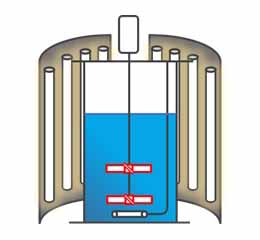 |
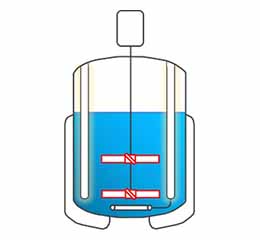 |
| Recommended Configurations (Design) | ||
| Vessel | Cylindrical vessel (Flat-plate bottom) |
Cylindrical vessel (10% Torispherical head) |
| Impeller | Pitched paddle type | |
| Aeration | Ring sparger | |
| Antifoaming impeller | No need | |
| Special | Light irradiation system (only in benchtop and pilot-scale) | |
| Recommended Configurations (measuring and control) | ||
| Temperature | ✔ | |
| Agitating speed | ✔ | |
| DO | ✔(Aerobic culture) | |
| pH | ✔ | |
| Bubble detect | No need | |
| Turbidity | N/A | |
| ORP | ✔(Anaerobic culture) | |
| FEED | ✔ | |
| O2/CO2/N2 | O2/CO2 | |
When it comes to the culture of plant cells, many people associate with callus culture. Here we show recommended configuration of a bioreactor for callus culture in liquid media.
Plant cells are sensitive to shear stress, so we recommend using a pitched paddle type impeller which can agitate with relatively low shear stress. In callus culture, culture broth sometimes becomes more viscous suddenly. We also recommend applying a helical ribbon impeller or “Max-blend impeller” (from Sumitomo Heavy Industries Process Equipment Co., Ltd.), which are used for media with high viscosity.
Plant cells are known to control its growth or differentiation by light condition (intensity, wavelength, period etc.) and to change its profile of secondary metabolites productions. We offer closed photobioreactor for more precise plant cell culture.
Oxygen consumption rate of Plant cells are low compared to general microorganisms and they can produce O2 by photosynthesis, so you may not puzzle over insufficient DO. Adding O2 gas is not necessary, but if you plan to analyze carbon fixation by photosynthesis, adding O2 and CO2 gases is recommended.
*There is a wide variety of types in pitched paddle impeller. We select or make an impeller which suits you. If you are interested in, please feel free to contact us.
For Hairy roots
| Benchtop Bioreactors | Pilot/Plant-Scale Bioreactors | |
| Image | 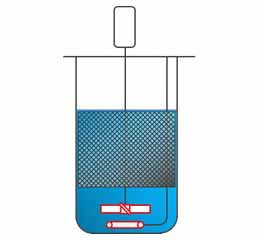 |
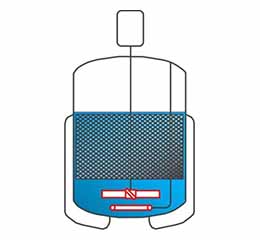 |
| Recommended Configurations (Design) | ||
| Vessel | Cylindrical vessel (beaker-like) |
Cylindrical vessel (10% Torispherical head) |
| Impeller | Pitched paddle type | |
| Aeration | Microbubble sparger | |
| Antifoaming impeller | No need | |
| Special | With mesh basket or Air-lift bioreactor | |
| Recommended Configurations (measuring and control) | ||
| Temperature | ✔ | |
| Agitating speed | ✔ | |
| DO | ✔(Aerobic culture) | |
| pH | ✔ | |
| Bubble detect | No need | |
| Turbidity | N/A | |
| ORP | ✔(Anaerobic culture) | |
| FEED | ✔ | |
| O2/CO2/N2 | O2/CO2 | |
airy roots, also known as transformed roots, are root-like tissues of plants which are occurred when a plant is infected with soil bacterium Rhizobium rhizogenes. It can be said that hairy roots are kinds of a tumor for plants. Plants are known to produce a lot kind of useful secondary metabolites such as alkaloids and therefore plants culture for production of these useful materials are attempted for long times. Plants often make these metabolites in their roots and previous research show that hairy roots also produce them. In addition, they grow easily and unlimitedly. Hairy roots are a helpful tool for manufacturing of biomaterials derived from plants.
The cultural condition does not differ from that of plant cells, but it is important to note that hairy roots are not a single cell but tissue, unlike other culture target. Moreover, they are more sensitive to shear force than plants callus. For these reasons, damage for rotating of the impeller need to be avoided. We offer a bioreactor with a mesh basket and it can separate hairy roots from impeller. We also recommend an air-lift bioreactor, where media is mixed by aeration. Control of light condition may be needed in some cases.
*There is a wide variety of types in pitched paddle impeller. We select or make an impeller which suits you. If you are interested in, please feel free to contact us.
